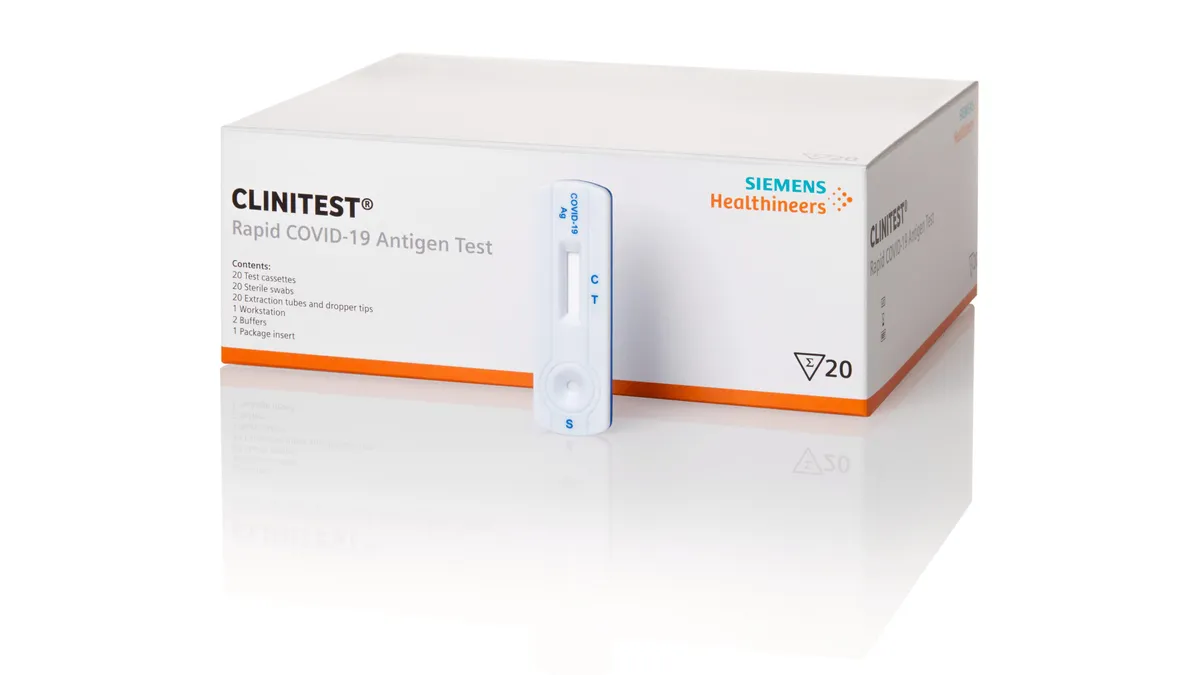Dive Brief:
- Siemens Healthineers has increased its full-year sales growth forecast after seeing demand for COVID-19 rapid antigen tests take off over the final three months of 2021.
- Having sold $374 million (€329 million) worth of COVID-19 rapid antigen tests in the first quarter of its fiscal year, Siemens now expects the products to generate revenues of approximately $796 million for the full year. The company previously expected full-year sales of about $228 million.
- The positive effect of the booming COVID-19 testing business on margins was offset by higher logistics and procurement costs. Siemens expects the headwind to ease throughout 2022, pointing to the stabilization of the supply of some components to support its viewpoint.
Dive Insight:
A lot has changed since Siemens set out its expectations for 2022 late last year. The explosive growth of the omicron variant meant sales of COVID-19 rapid antigen tests in the first quarter exceeded Siemens' prior full-year forecast. The company generated those sales before bringing its test to market in the U.S., with Europe being the main driver of the revenues.
Neither omicron nor the FDA emergency use authorization were factored into Siemens' original revenue guidance. Siemens expects those two forces to contribute to strong demand for rapid antigen tests in the second quarter, before sales may fall away during the summer months.
"Pricing has come down substantially for tenders in Germany. And considering we are not the only player to receive a U.S. approval for its COVID-19 antigen test, we should see how pricing and volumes evolve over time in the United States," CFO Jochen Schmitz said during a Thursday earnings call. "So, the overall market becomes more and more competitive. Therefore, we expect revenues to decline sharply in the second half."
The company's U.S. strategy is focused on large customers. The top target is big government programs, an area in which Siemens has had success in Europe, but the company is now also looking at larger retail chains.
After factoring that opportunity into its outlook, Siemens now expects comparable revenue growth of 3% to 5% for the full year, up from 0% to 2% in its earlier guidance. Siemens also bumped up its earnings per share forecast. The revised outlook reflects the assumption that procurement and logistics costs will start to normalize in the second half of the year. The costs were a headwind in the first quarter.
"We did not see material impact on our revenues from supply chain issues so far, and we assume that we will not see material impacts going forward," Schmitz said. "We see headwinds. These headwinds have two main drivers. One driver is price increases due to shortages, most notable in electronic components and in certain raw materials like metals. The other driver is logistic costs, including structural changes, e.g. switching from sea to air freight, and mitigation measures in our manufacturing."
After Siemens made its original forecast for 2022, shortages and the need to buy certain components at "spot rates" rose.
"The tension just increased across the board," Schmitz said. Siemens sees encouraging signs that better days may be ahead, though, with the stabilization of component supply giving the CFO confidence that the organization can perform over the rest of the year.










